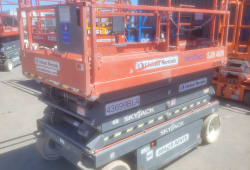Pros and Cons of Heavy Equipment Refurbishment: Exploring the Benefits
12 Lectura mínima
)
agosto 11, 2023
Heavy equipment refurbishment is a process that provides numerous benefits for businesses in various industries. Understanding the concept, advantages, and disadvantages of heavy equipment refurbishment is crucial for making informed decisions about maintenance and equipment management strategies. In this article, we will explore the pros and cons of heavy equipment refurbishment and delve into its benefits in detail.
Understanding Heavy Equipment Refurbishment
Heavy equipment refurbishment is a meticulous and intricate process that involves restoring used or worn-out machinery to its original or near-original condition. It goes beyond mere repairs and encompasses a comprehensive approach to breathe new life into aging equipment. By optimizing performance and extending their lifespan, businesses can maximize their investment in heavy machinery.
What is Heavy Equipment Refurbishment?
Heavy equipment refurbishment is not simply a cosmetic makeover; it is a transformative process. It begins by carefully assessing the condition of the machinery to determine the extent of refurbishment required. This initial inspection is crucial in identifying areas that need attention and creating a roadmap for the refurbishment process.
Once the equipment is disassembled, the true work of refurbishment begins. Damaged or worn components are carefully replaced, ensuring that the equipment meets or exceeds its original specifications. Skilled technicians meticulously carry out necessary repairs, utilizing a range of techniques such as welding, machining, and painting to restore the equipment to its former glory.
However, refurbishment is not merely about fixing what is broken; it is also about enhancing the equipment's performance. In addition to repairs, improvements and upgrades may be implemented to optimize the machinery's efficiency and functionality. This could involve incorporating advanced technologies or modifying certain components to meet modern industry standards.
The Process of Refurbishing Heavy Equipment
The process of refurbishing heavy equipment is a multi-step endeavor that requires expertise and attention to detail. After the initial inspection, where the condition of the equipment is thoroughly evaluated, the refurbishment process commences.
With the equipment disassembled, the worn-out or damaged components are carefully replaced. Skilled technicians meticulously assess each part, ensuring that only the highest quality replacements are used. From hydraulic systems to electrical components, every aspect of the equipment is meticulously inspected and restored to its optimal condition.
Once the necessary repairs and component replacements are completed, the equipment undergoes a series of tests to ensure its functionality and reliability. These tests are designed to simulate real-world operating conditions, pushing the equipment to its limits to verify its performance. Only after passing these rigorous tests is the equipment deemed ready for use.
Furthermore, refurbishment is not limited to the mechanical aspects of the equipment. Aesthetics also play a significant role. The machinery is thoroughly cleaned, removing years of grime and dirt, and often receives a fresh coat of paint. This not only enhances its visual appeal but also provides a protective layer against corrosion and wear.
In conclusion, heavy equipment refurbishment is a comprehensive process that breathes new life into aging machinery. By meticulously assessing, repairing, and replacing components, businesses can optimize the performance and extend the lifespan of their heavy equipment. Through this transformative process, companies can maximize their investment, ensuring that their machinery remains efficient and reliable for years to come.
The Advantages of Heavy Equipment Refurbishment
Heavy equipment refurbishment offers numerous benefits that can greatly impact businesses in various industries. Not only does it provide cost savings, but it also contributes to environmental sustainability, extends the lifespan of equipment, and improves efficiency and performance.
Cost Savings
One of the primary advantages of heavy equipment refurbishment is the significant cost savings it offers. For businesses operating on tight budgets, purchasing new machinery may not be a feasible option. However, by choosing to refurbish equipment, companies can achieve substantial savings. Refurbished equipment can perform just as well as new machinery but at a fraction of the cost. This allows businesses to allocate their resources more efficiently and invest in other areas of their operations.
Environmental Benefits
Another crucial aspect of heavy equipment refurbishment is its positive impact on the environment. By opting for refurbishment over replacement, businesses actively contribute to environmental sustainability. Manufacturing new machinery consumes valuable resources and produces carbon emissions. However, refurbishing equipment reduces the need for new manufacturing, thus minimizing resource consumption and carbon emissions. Additionally, refurbishment plays a vital role in reducing landfill waste by extending the useful life of existing equipment. This sustainable approach helps preserve the environment for future generations.
Extended Equipment Lifespan
Refurbishment significantly extends the lifespan of heavy equipment, allowing businesses to maximize their investment. Through repairs and component replacements, worn-out parts are revitalized, ensuring optimal functionality. By addressing any existing issues and performing necessary maintenance during the refurbishment process, the equipment can continue operating efficiently for many years. This not only enhances productivity but also reduces the need for frequent replacements, saving businesses both time and money.
Improved Efficiency and Performance
Refurbishing heavy equipment often leads to improved efficiency and performance, which directly impacts a business's productivity and profitability. During the refurbishment process, outdated technology and components can be upgraded to more advanced versions, optimizing equipment capabilities. This results in enhanced productivity, as the equipment can perform tasks more effectively and efficiently. Additionally, improved performance reduces downtime, minimizing disruptions to operations and maximizing output. Ultimately, this increased efficiency translates into higher profitability for businesses.
In conclusion, heavy equipment refurbishment offers a range of advantages that can positively impact businesses. From cost savings to environmental sustainability, and extended lifespan to improved efficiency and performance, refurbishing equipment provides a cost-effective and sustainable solution for businesses operating in various industries.
The Disadvantages of Heavy Equipment Refurbishment
Heavy equipment refurbishment is a process that involves restoring used machinery to a functional and operational state. While it offers several advantages, there are also some disadvantages to consider. Understanding these drawbacks can help businesses make informed decisions when it comes to refurbishing their heavy equipment.
Time Consumption
One potential drawback of heavy equipment refurbishment is the time required to complete the process. Refurbishment can be a lengthy process, involving meticulous inspection, repairs, and testing. Each piece of equipment requires careful assessment to identify any underlying issues and determine the extent of refurbishment needed. Additionally, the availability of spare parts and the complexity of repairs can further contribute to the overall time consumption.
However, it is important to consider the long-term benefits that come with refurbished equipment. While the refurbishment process may cause temporary disruption to operations, it can significantly extend the lifespan of the machinery, resulting in cost savings in the long run.
Potential Quality Issues
Another consideration when opting for heavy equipment refurbishment is the possibility of encountering quality issues. Although refurbishment aims to restore equipment to its original condition, there is a chance that some components may not perform as well as brand-new replacements. This can be due to factors such as wear and tear, limitations in the refurbishment process, or the availability of specific parts.
Therefore, it is crucial to engage reputable refurbishment service providers with a track record of excellence. Choosing experienced professionals who have extensive knowledge of the equipment being refurbished can help minimize the risk of encountering quality issues. Additionally, thorough testing and quality control measures should be implemented to ensure that the refurbished machinery meets the required standards.
Limited Warranty and Support
Unlike new equipment purchases, refurbished heavy equipment may come with limited warranty options. Refurbished machinery might have shorter warranty periods compared to new equipment, which could potentially affect repair and maintenance costs. However, businesses can mitigate this concern by partnering with reputable refurbishment providers who offer post-refurbishment support and regular maintenance services.
By establishing a strong relationship with the refurbishment service provider, businesses can ensure access to ongoing technical support, guidance, and maintenance services. This can help address any issues that may arise during the warranty period and provide peace of mind to the equipment owners.
In conclusion, while heavy equipment refurbishment offers numerous benefits such as cost savings and extended equipment lifespan, it is essential to consider the potential drawbacks. The time consumption involved in the refurbishment process, the possibility of encountering quality issues, and the limited warranty options are factors that businesses need to carefully evaluate. By partnering with reputable refurbishment service providers and implementing thorough quality control measures, these disadvantages can be effectively managed, allowing businesses to make the most out of their refurbished heavy equipment.
Case Studies: Successful Heavy Equipment Refurbishment
When it comes to heavy equipment refurbishment, the impact can be truly transformative for businesses across different industries. In this section, we will delve into two case studies that highlight the success stories of companies that chose to refurbish their equipment rather than purchase new ones.
Case Study 1: Refurbishment in the Construction Industry
One construction company, faced with budget constraints, decided to take a different approach to its fleet of excavators. Instead of investing in brand-new equipment, they opted for refurbishment. The process involved a comprehensive overhaul that addressed engine issues, replaced damaged hydraulic cylinders, and upgraded control systems.
The results were astounding. Not only did the refurbishment save the company over 40% of the cost compared to buying new equipment, but the performance of the refurbished excavators was also on par with their brand-new counterparts. These excavators proved to be just as effective in various construction projects, allowing the company to complete its tasks efficiently and within budget.
Case Study 2: Refurbishment in the Mining Industry
In the mining industry, where productivity and efficiency are paramount, one mining company sought to optimize its operations without overspending on new equipment. They turned to refurbishment as a cost-effective solution.
The company chose to refurbish its large mining trucks, which required extensive work such as engine overhauls and the implementation of improved safety features. The refurbishment not only extended the equipment's lifespan but also resulted in significant cost savings for the company.
By refurbishing its mining trucks, the company was able to maintain operational efficiency while allocating resources to other critical areas of its mining operations. This strategic decision allowed them to maximize their productivity without compromising on safety or breaking the bank.
These case studies highlight the immense benefits that can be achieved through heavy equipment refurbishment. Whether it's in the construction or mining industry, refurbishing equipment offers a cost-effective alternative to purchasing new machinery. Not only does it save money, but it also ensures that the refurbished equipment performs just as effectively as new ones, enabling businesses to thrive and succeed in their respective industries.
Making the Decision: Is Refurbishment Right for Your Equipment?
When it comes to heavy equipment, deciding between refurbishment and replacement can be a complex process. Several factors should be carefully considered to determine the best course of action. These factors include the age of the equipment, its current condition, the cost of refurbishment, the potential return on investment, and the availability of new equipment that meets the business needs.
Age plays a significant role in the decision-making process. Older equipment may require more frequent repairs and maintenance, making refurbishment a viable option to extend its lifespan. However, if the equipment is already outdated and beyond repair, replacement might be the more appropriate choice.
Another crucial factor is the current condition of the equipment. If the machinery is in good overall shape, refurbishment can address any specific issues and bring it back to optimal working conditions. On the other hand, if the equipment has significant structural damage or mechanical failures, replacement might be the only viable solution.
The cost of refurbishment is also a key consideration. If refurbishment costs are significantly lower than purchasing new machinery, it can be a cost-effective option. However, it is important to evaluate the long-term financial implications and potential return on investment. Sometimes, investing in new equipment that offers improved efficiency and productivity can outweigh the benefits of refurbishment.
Availability is another aspect to take into account. If new equipment that meets the business needs is readily available, it may be more convenient to opt for replacement. However, if the required machinery is not easily accessible or has a long lead time, refurbishment can provide a quick and efficient solution to keep operations running smoothly.
When to Choose Refurbishment Over Replacement
Choosing between refurbishment and replacement ultimately depends on the specific circumstances. If the existing equipment serves its purpose well and refurbishment costs are significantly lower than purchasing new machinery, refurbishment is often the preferred choice. It allows businesses to maintain their current operations without incurring substantial expenses.
The refurbishment also offers the advantage of preserving the familiarity and expertise that employees have with the existing equipment. This can reduce the need for extensive retraining and minimize disruptions in workflow. Additionally, refurbishment can be a more environmentally sustainable option, as it reduces waste and extends the lifespan of the equipment.
However, there are situations where replacement is the more appropriate decision. If the equipment is outdated and no longer meets industry standards or regulatory requirements, investing in new technology may be necessary. New machinery often offers substantial long-term benefits, such as improved efficiency, advanced features, and enhanced safety measures.
Seeking Professional Advice
When considering heavy equipment refurbishment, it is essential to seek professional advice from experienced refurbishment service providers. These experts have the knowledge and expertise to assess the condition of the equipment accurately. They can provide detailed cost estimates for refurbishment and offer insights into the benefits and limitations of this option.
Professional advice is invaluable in making informed decisions based on the unique requirements of each business. By consulting with refurbishment service providers, businesses can gain a comprehensive understanding of the potential outcomes of refurbishment and make well-informed choices.
In conclusion, heavy equipment refurbishment offers numerous benefits, including cost savings, environmental sustainability, extended lifespan, and improved efficiency. While there may be potential challenges, such as time consumption and quality concerns, these can be mitigated through careful evaluation and selection of reputable refurbishment providers.
By thoroughly assessing the age, condition, cost, potential return on investment, and availability of new equipment, businesses can determine whether refurbishment is the right choice for their machinery. Making informed decisions regarding heavy equipment refurbishment can optimize operations, contribute positively to the bottom line, and ensure the longevity of the equipment.

Javier Bocanegra is Boom & Bucket's Technical Resolutions Lead, drawing on 10+ years in automotive and heavy equipment to diagnose issues, resolve complex post-sale cases, and keep machines - and customers - running smoothly. A certified heavy-equipment specialist, he's known for meticulous inspections and hands-on expertise across mechanical, electrical, and hydraulic systems. Based in Sacramento, Javier partners closely with buyers, vendors, and our field teams to deliver reliable outcomes and uphold our standards for safety and trust.














